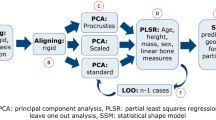Abstract
The objective of the research is to determine if principal component analysis (PCA) provides an efficient method to characterise the normative shape of the proximal tibia. Bone surface data, converted to analytical surface descriptions, are aligned, and an auto-associative memory matrix is generated. A limited subset of the matrix principal components is used to reconstruct the bone surfaces, and the reconstruction error is assessed. Surface reconstructions based on just six (of 1452) principal components have a mean root-mean-square (RMS) reconstruction error of 1.05% of the mean maximum radial distance at the tibial plateau. Surface reconstruction of bones not included in the auto-associative memory matrix have a mean RMS error of 2.90%. The first principal component represents the average shape of the sample population. Addition of subsequent principal components represents the shape variations most prevalent in the sample and can be visualised in a geometrically meaningful manner. PCA offers an efficient method to characterise the normative shape of the proximal tibia with a high degree of dimensionality reduction.
Similar content being viewed by others
References
Anderson, J. A. (1995): ‘An introduction to neural networks’ (MIT Press, Cambridge)
Armitage, P., andBerry, P. (1994): ‘Statistical methods in medical research’ (Blackwell Scientific, Boston)
Belsole, R. J., Hilbelink, D. R., Llewellyn, J. A., Dale, M., Ogden, J. A. (1991): ‘Carpal orientation from computed reference axes’,J. Hand Surg. Am.,16, pp. 82–90
Dunteman, G. H. (1989): ‘Principal components analysis’ (Sage, Newbury Park)
Flury, B. (1988): ‘Common principal components and related multivariate models’ (John Wiley & Sons, Inc)
Hafner, B. J., Zachariah, S. G., andSanders, J. E. (1998): ‘Automated alignment of contour pairs: A hybrid approach with applications to prosthetics’. Proc. 1998 RESNA Annual Conf., Minneapolis, Minnesota, pp. 272–274
Hotelling, H. (1933): ‘Analysis of a complex of statistical variables into principal components’,J. Educ. Psychol.,24, pp. 417–441, 498–520
Isebrands, J. G., andCrow, T. R. (1975): ‘Introduction to uses and interpretation of principal component analysis in forest biology’ (Forest Service, U.S. Department of Agriculture)
Kirby, M., andSirovich, L., (1990): ‘Application of the Karhunen-Loeve procedure for the characterization of human faces’,IEEE Trans. Pattern Anal. Mach. Intell.,12, pp. 103–108
Kroemer, K. H. E., Kroemer, H. B., andKroemer-Elbert, K. E. (1994): ‘Ergonomics: How to design for ease and efficiency’ (Prentice Hall, Englewood Cliffs)
O'Toole, A. J., Abdi, H., Deffenbacher, K. A., andValentin, D. (1993): ‘Low-dimensional representation of faces in higher dimensions of the face space’,J. Opt. Soc. Am. A,10, pp. 405–411
Ostle, B., andMalone, L. C. (1988): ‘Statistics in research: basic concepts and techniques for research workers’ (Iowa State University Press), p. 536
Pearson, K. (1901): ‘On lines and planes of closest fit to systems of points in space’,Phil. Mag., May 2, pp. 559–572
Pentland, A., Moghaddam, B., andStarner, T. (1994): ‘View-based and modular eigenspaces for face recognition’, Proc. IEEE Conf. Comput. vis. pattern recognit., Seattle, Washington, pp. 84–91
Preisendorfer, R. W., andMobley, C. D. (1988): ‘Principal component analysis in meteorology and oceanography’ (Elsevier Science Publishing Company, Inc.)
Toga, A. W., andBanerjee, P. K. (1993): ‘Registration revisited’,J. Neurosci. Methods,48, pp. 1–13
Weber, D. A., andIvanovic, M. (1994): ‘Correlative image registration’,Semin. Nucl. Med.,24, pp. 311–323
Yehia, H., andTiede, M. (1997): ‘A parametric three-dimensional model of the vocal-tract based on MRI data’. IEEE Int. Conf. Acoust. Speech Signal Processing, Munich, Germany, pp. 1619–1622
Zachariah, S. G., Sanders, J. E., andTurkiyyah, G. M. (1996): ‘Automated hexahedral mesh generation from biomedical image data: applications in limb prosthetics’,IEEE Trans. Rehab. Eng.,4, pp. 91–102
Author information
Authors and Affiliations
Corresponding author
Rights and permissions
About this article
Cite this article
Hafner, B.J., Zachariah, S.G. & Sanders, J.E. Characterisation of three-dimensional anatomic shapes using principal components: Application to the proximal tibia. Med. Biol. Eng. Comput. 38, 9–16 (2000). https://doi.org/10.1007/BF02344682
Received:
Accepted:
Issue Date:
DOI: https://doi.org/10.1007/BF02344682




